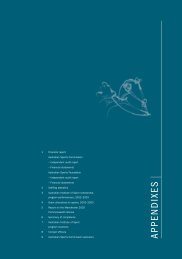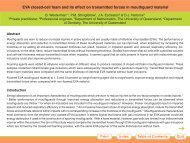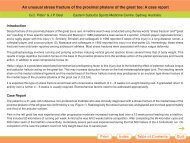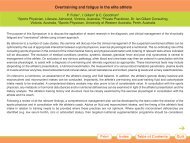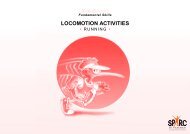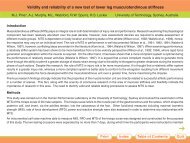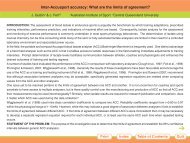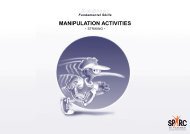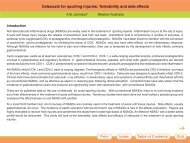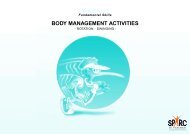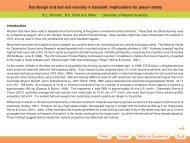Excellence in performance enhancement consulting
Excellence in performance enhancement consulting
Excellence in performance enhancement consulting
You also want an ePaper? Increase the reach of your titles
YUMPU automatically turns print PDFs into web optimized ePapers that Google loves.
<strong>Excellence</strong> <strong>in</strong> <strong>performance</strong> <strong>enhancement</strong> consult<strong>in</strong>g<br />
K. Ravizza* California State University at Fullerton<br />
A consult<strong>in</strong>g practice <strong>in</strong>volves both the art and the science of applied sport psychology. I have had the privilege of work<strong>in</strong>g with many elite level<br />
coaches and athletes. In my early years, while many of my colleagues were work<strong>in</strong>g <strong>in</strong> the lab, I made the choice to work on the play<strong>in</strong>g fields<br />
with coaches and athletes and utilize my phenomenological background to study the human experience of coaches and athletes. It is important<br />
to mention that my academic tra<strong>in</strong><strong>in</strong>g was <strong>in</strong> Sport Philosophy with an emphasis <strong>in</strong> existential and phenomenological thought and methods, as<br />
well as Eastern Philosophy, specifically Zen and Hatha Yoga. When I was <strong>in</strong> graduate school, Sport Psychology was just beg<strong>in</strong>n<strong>in</strong>g as a field<br />
and it was primarily a research/motor-learn<strong>in</strong>g field of study.<br />
California State University at Fullerton allowed me the opportunity to expand my perspective and work with student/athletes <strong>in</strong> the area of<br />
Performance Enhancement. My approach has always been grounded <strong>in</strong> existential philosophy and the phenomenological method, and throughout<br />
my career I have worked with both philosophical and psychological skills. I have found that when an athlete knows why she or he is perform<strong>in</strong>g,<br />
it helps the athlete persevere through the difficult periods <strong>in</strong> the journey of excellence (Frankl, 1984). Elite athletes have a love/hate relationship<br />
with their sport. Sport participation can be wonderful and ecstatic, but at times it can truly humble the performer. And this is why the athlete<br />
must know why she or he is perform<strong>in</strong>g so that he or she has a solid foundation to cope with adversity.<br />
Ma<strong>in</strong>ta<strong>in</strong><strong>in</strong>g a balance between the philosophical issues and psychological techniques has always been a part of my work. Sometimes I have<br />
been too quick to “fix” th<strong>in</strong>gs with some technique, i.e. relaxation, imagery, concentration tra<strong>in</strong><strong>in</strong>g, when the real issue is truly the athlete’s<br />
perspective or value that is be<strong>in</strong>g placed on the issue. When the philosophical issues are addressed, it has an impact on so many diverse<br />
levels.<br />
Sport by def<strong>in</strong>ition is an absurd task where the athlete must f<strong>in</strong>d mean<strong>in</strong>g <strong>in</strong> the act of participation. The athlete is required to accept his/her<br />
freedom and make choices and take responsibility for one’s actions. The athlete is a performer who must “stand naked before the gods”, fully<br />
exposed where actions count (Metheny, 1968). It is this dimension of sport that makes it such a powerful experience.<br />
My phenomenological background has helped me value and learn from the coach’s/athlete’s experience. Part of this learn<strong>in</strong>g experience has<br />
been to develop my observational skills so that I am more aware of what is go<strong>in</strong>g on. I have spent countless hours just watch<strong>in</strong>g athletes/<br />
coaches perform <strong>in</strong> practice as well as <strong>in</strong> the competitive arena.<br />
Pr<strong>in</strong>t<br />
Index<br />
Table of Contents<br />
Quit
<strong>Excellence</strong> <strong>in</strong> <strong>performance</strong> <strong>enhancement</strong> consult<strong>in</strong>g<br />
K. Ravizza* California State University at Fullerton<br />
The basic philosophy of my approach is grounded <strong>in</strong> a humanistic, holistic and proactive perspective. I value the <strong>in</strong>dividual’s experience, am<br />
concerned about the total person and I want the athlete to focus on what they have control of. I <strong>in</strong>corporate a collaborative approach by work<strong>in</strong>g<br />
closely with the coach<strong>in</strong>g staff, and I <strong>in</strong>tegrate my <strong>in</strong>formation and skills <strong>in</strong>to exist<strong>in</strong>g protocols. I have also found that a consultant must be<br />
flexible and learn to work <strong>in</strong> a multitude of diverse situations (Ravizza, 2001).<br />
I have found that consult<strong>in</strong>g <strong>in</strong> the area of <strong>performance</strong> <strong>enhancement</strong> has varied depend<strong>in</strong>g upon the context of the situation that I am work<strong>in</strong>g<br />
<strong>in</strong>. I tell athletes that there are no two <strong>performance</strong>s that are the same; there are no two consult<strong>in</strong>g experiences that are the same. Some of<br />
the variables that are go<strong>in</strong>g to alter the experience are the nature of the sport, coach<strong>in</strong>g staff support, access to the athletes, organizational<br />
politics, etc. All of these factors and a multitude of additional factors must be confronted, and dealt with <strong>in</strong> order to develop an effective<br />
program.<br />
Consultation <strong>in</strong>cludes five major tasks, which must be accomplished. They are: ga<strong>in</strong><strong>in</strong>g entry, assessment of the situation, delivery of the<br />
program and program evaluation. The f<strong>in</strong>al aspect that will be addressed are the potential pitfalls that one might confront.<br />
Entry<br />
It is critical to know the sport <strong>in</strong> which you are work<strong>in</strong>g, and the psychological demands that the athletes/coaches must contend with. For<br />
example, team vs. <strong>in</strong>dividual, contact vs. non-contact, objective vs. subjective evaluation, etc. The consultant must also become knowledgeable<br />
of the coach’s orientation, reputation and pressures that he or she must contend with. Credibility and trust must be earned at all levels: from<br />
coaches, to tra<strong>in</strong>ers, to equipment room personnel. When you are an outsider com<strong>in</strong>g <strong>in</strong>to a new culture, some people are go<strong>in</strong>g to be<br />
threatened by you, and for this reason, it is important to form good work<strong>in</strong>g relationships at all levels and clarify the services that you will provide<br />
to the team. I have found the athletic tra<strong>in</strong>ers and/or physical therapists often feel that <strong>performance</strong> <strong>enhancement</strong> consultants are <strong>in</strong>fr<strong>in</strong>g<strong>in</strong>g on<br />
their territory s<strong>in</strong>ce they are the caregivers (Ravizza, 1988; Orlick, 1989; Ogilvie and Henschen, 1995).<br />
At some po<strong>in</strong>t, a presentation will be needed for either the coach<strong>in</strong>g staff and/or the players to expla<strong>in</strong> the program you have developed. This<br />
must be a captivat<strong>in</strong>g, motivat<strong>in</strong>g and stimulat<strong>in</strong>g presentation that truly gets them excited. This is where the consultant needs to speak the<br />
language of the athletes and demonstrate that they have someth<strong>in</strong>g of benefit to ga<strong>in</strong> from gett<strong>in</strong>g <strong>in</strong>volved <strong>in</strong> the program.<br />
Pr<strong>in</strong>t<br />
Index<br />
Table of Contents<br />
Quit
Assessment<br />
<strong>Excellence</strong> <strong>in</strong> <strong>performance</strong> <strong>enhancement</strong> consult<strong>in</strong>g<br />
K. Ravizza* California State University at Fullerton<br />
As a consultant, you must assess the situation and determ<strong>in</strong>e the context of the situation that you will be work<strong>in</strong>g <strong>in</strong>. I want to clarify that by<br />
assessment, I do not mean written psychological assessment, but assessment of the work<strong>in</strong>g situation and the unique sub-culture of that team.<br />
I need to determ<strong>in</strong>e who are the key people that I need to get to support the program, i.e. team leaders, a certa<strong>in</strong> coach, etc. I need to<br />
determ<strong>in</strong>e the support for the program. How much time I will have? How much access I will have to the coaches and players? When and<br />
where will I be giv<strong>in</strong>g presentations to the team?<br />
In this assessment phase, it is critical to be open to verbal and non-verbal feedback and constantly make on-go<strong>in</strong>g adjustments. I also want to<br />
access and establish referral resources and procedures.<br />
Program Delivery<br />
How will the program actually be developed and delivered to the team? Will it be targeted for the coaches and teach<strong>in</strong>g them to do it, or will it<br />
be delivered directly to the players? Will the program be presented <strong>in</strong> a group and/or <strong>in</strong>dividual basis? As a consultant, hopefully you will be<br />
collaborat<strong>in</strong>g closely with the coach<strong>in</strong>g staff <strong>in</strong> the delivery of the program. The key is to figure out the context of the situation that you will be<br />
work<strong>in</strong>g <strong>in</strong> and develop the most effective program for that context. An important part of the delivery is what type of access you will have with<br />
the players. Will you be able to attend practices and games? Will you be able to provide <strong>in</strong>put at practices and games (Poczwardowski, A.,<br />
Sherman, C., Henschen, K.C., 1998).<br />
Program Evaluation<br />
As you go through the consult<strong>in</strong>g process, you will get on-go<strong>in</strong>g feedback on your program. The consultant cannot wait until the end of the<br />
season to evaluate the program, but must constantly assess the situation. Major “red flags” <strong>in</strong>clude: phone calls to the coach are suddenly not<br />
be<strong>in</strong>g returned and/or access to the team is decreas<strong>in</strong>g. The key to program evaluation is that you are work<strong>in</strong>g with enough athletes so that you<br />
are at least mak<strong>in</strong>g a difference with a couple of them. Coaches know that not everyone will be totally supportive of your program, but you need<br />
to work with those who are supportive and not become an irritant and/or distraction to others. The key to program evaluation is that you<br />
determ<strong>in</strong>e <strong>in</strong> collaboration with the coach<strong>in</strong>g staff, the effectiveness of the program and that you are <strong>in</strong>vited back the follow<strong>in</strong>g season.<br />
Pr<strong>in</strong>t<br />
Index<br />
Table of Contents<br />
Quit
<strong>Excellence</strong> <strong>in</strong> <strong>performance</strong> <strong>enhancement</strong> consult<strong>in</strong>g<br />
K. Ravizza* California State University at Fullerton<br />
Potential Pitfalls<br />
The biggest issue for me is the “shr<strong>in</strong>k image”, I am not a psychologist, but the stereotype is difficult to overcome. ”“I am okay, Doc.” I hear this<br />
so often when the athletes aren’t clear what it is that I do. I keep tell<strong>in</strong>g them my approach is proactive; it is about what it takes to be great. It<br />
is not a reactive approach where the athlete is “messed” up and I am go<strong>in</strong>g to fix him/her.<br />
Another pitfall is not understand<strong>in</strong>g the sport and unique demands with which the athlete must contend. Closely associated with this is<br />
<strong>in</strong>adequate knowledge of the politics of the situation. This is especially critical with Olympic and Professional sports (Woodman, T. & Hardy, L.,<br />
2001).<br />
Be careful not to take a research and/or theoretical orientation with elite athletes. In all my years of consult<strong>in</strong>g, I have never been asked to<br />
show any coaches my publications; they only want to know with whom I have worked. One f<strong>in</strong>al po<strong>in</strong>t is be careful to ma<strong>in</strong>ta<strong>in</strong> patience <strong>in</strong><br />
deliver<strong>in</strong>g the program. If you come on too strong, you are go<strong>in</strong>g to turn people off. So the consultant has to f<strong>in</strong>d that delicate balance between<br />
be<strong>in</strong>g assertive and patient <strong>in</strong> provid<strong>in</strong>g assistance.<br />
In summary, every consult<strong>in</strong>g experience is unique and one must assess the unique context of the particular situation and learn the delicate<br />
balance or act of design<strong>in</strong>g and deliver<strong>in</strong>g an effective program to effectively meet the needs of that unique situation.<br />
References<br />
Frankl, V. (1984). Man’s Search for Mean<strong>in</strong>g. N.Y.: Touchstone Books.<br />
Metheny, E. (1968). Movement & Mean<strong>in</strong>g. N.Y.: McGraw-Hill.<br />
Orlick, T (1989). Reflections on sport psychology consult<strong>in</strong>g with <strong>in</strong>dividual and team sport athletes at the Summer and W<strong>in</strong>ter Olympic Games.<br />
The Sport Psychologist, 3, 358-365.<br />
Ravizza, K. (1988). Ga<strong>in</strong><strong>in</strong>g entry with athlete personnel for season long consult<strong>in</strong>g. The Sport Psychologist, 2, 243-254.<br />
Olgilvie, B. & Henschen, K. (1995). The art of application of psychological enhanc<strong>in</strong>g pr<strong>in</strong>ciples. In. K.P. Henschen & W.F. Straub, (Eds.), Sport<br />
Psychology: An Analysis of Athlete Behavior. (2 nd ed., pp. 45-54). Longmeadow, MA: Movement Publications.<br />
Poczwardowski, A., Sherman, C. & Henschen, K. (1998). A Sport Psychology Service Delivery Heuristic Build<strong>in</strong>g on Theory & Practice. The<br />
Sport Psychologist, 12, 192-208.<br />
Woodman, T. & Hardy, L. (2001). A Case Study of Organizational Stress <strong>in</strong> Elite Sport. Journal of Applied Sport Psychology,<br />
13, 207-238.<br />
Pr<strong>in</strong>t<br />
Index<br />
Table of Contents<br />
Quit
<strong>Excellence</strong> <strong>in</strong> <strong>performance</strong> <strong>enhancement</strong> consult<strong>in</strong>g<br />
K. Ravizza*<br />
California State University at Fullerton<br />
A consult<strong>in</strong>g practice <strong>in</strong>volves both the art and the science of applied sport psychology. I have had the privilege of work<strong>in</strong>g<br />
with many elite level coaches and athletes. In my early years, while many of my colleagues were work<strong>in</strong>g <strong>in</strong> the lab, I made the<br />
choice to work on the play<strong>in</strong>g fields with coaches and athletes and utilize my phenomenological background to study the human<br />
experience of coaches and athletes. It is important to mention that my academic tra<strong>in</strong><strong>in</strong>g was <strong>in</strong> Sport Philosophy with an<br />
emphasis <strong>in</strong> existential and phenomenological thought and methods, as well as Eastern Philosophy, specifically Zen and Hatha<br />
Yoga. When I was <strong>in</strong> graduate school, Sport Psychology was just beg<strong>in</strong>n<strong>in</strong>g as a field and it was primarily a research/motorlearn<strong>in</strong>g<br />
field of study.<br />
California State University at Fullerton allowed me the opportunity to expand my perspective and work with<br />
student/athletes <strong>in</strong> the area of Performance Enhancement. My approach has always been grounded <strong>in</strong> existential philosophy<br />
and the phenomenological method, and throughout my career I have worked with both philosophical and psychological skills. I<br />
have found that when an athlete knows why she or he is perform<strong>in</strong>g, it helps the athlete persevere through the difficult periods <strong>in</strong><br />
the journey of excellence (Frankl, 1984). Elite athletes have a love/hate relationship with their sport. Sport participation can be<br />
wonderful and ecstatic, but at times it can truly humble the performer. And this is why the athlete must know why she or he is<br />
perform<strong>in</strong>g so that he or she has a solid foundation to cope with adversity.<br />
Ma<strong>in</strong>ta<strong>in</strong><strong>in</strong>g a balance between the philosophical issues and psychological techniques has always been a part of my<br />
work. Sometimes I have been too quick to “fix” th<strong>in</strong>gs with some technique, i.e. relaxation, imagery, concentration tra<strong>in</strong><strong>in</strong>g, when<br />
the real issue is truly the athlete’s perspective or value that is be<strong>in</strong>g placed on the issue. When the philosophical issues are<br />
addressed, it has an impact on so many diverse levels.<br />
Sport by def<strong>in</strong>ition is an absurd task where the athlete must f<strong>in</strong>d mean<strong>in</strong>g <strong>in</strong> the act of participation. The athlete is<br />
required to accept his/her freedom and make choices and take responsibility for one’s actions. The athlete is a performer who<br />
must “stand naked before the gods”, fully exposed where actions count (Metheny, 1968). It is this dimension of sport that makes<br />
it such a powerful experience.<br />
My phenomenological background has helped me value and learn from the coach’s/athlete’s experience. Part of this<br />
learn<strong>in</strong>g experience has been to develop my observational skills so that I am more aware of what is go<strong>in</strong>g on. I have spent<br />
countless hours just watch<strong>in</strong>g athletes/coaches perform <strong>in</strong> practice as well as <strong>in</strong> the competitive arena.<br />
The basic philosophy of my approach is grounded <strong>in</strong> a humanistic, holistic and proactive perspective. I value the<br />
<strong>in</strong>dividual's experience, am concerned about the total person and I want the athlete to focus on what they have control of. I<br />
<strong>in</strong>corporate a collaborative approach by work<strong>in</strong>g closely with the coach<strong>in</strong>g staff, and I <strong>in</strong>tegrate my <strong>in</strong>formation and skills <strong>in</strong>to<br />
exist<strong>in</strong>g protocols. I have also found that a consultant must be flexible and learn to work <strong>in</strong> a multitude of diverse situations<br />
(Ravizza, 2001).<br />
I have found that consult<strong>in</strong>g <strong>in</strong> the area of <strong>performance</strong> <strong>enhancement</strong> has varied depend<strong>in</strong>g upon the context of the situation<br />
that I am work<strong>in</strong>g <strong>in</strong>. I tell athletes that there are no two <strong>performance</strong>s that are the same; there are no two consult<strong>in</strong>g<br />
experiences that are the same. Some of the variables that are go<strong>in</strong>g to alter the experience are the nature of the sport, coach<strong>in</strong>g<br />
staff support, access to the athletes, organizational politics, etc. All of these factors and a multitude of additional factors must be<br />
confronted, and dealt with <strong>in</strong> order to develop an effective program.<br />
Consultation <strong>in</strong>cludes five major tasks, which must be accomplished. They are: ga<strong>in</strong><strong>in</strong>g entry, assessment of the<br />
situation, delivery of the program and program evaluation. The f<strong>in</strong>al aspect that will be addressed are the potential pitfalls that<br />
one might confront.<br />
ENTRY: It is critical to know the sport <strong>in</strong> which you are work<strong>in</strong>g, and the psychological demands that the athletes/coaches<br />
must contend with. For example, team vs. <strong>in</strong>dividual, contact vs. non-contact, objective vs. subjective evaluation, etc. The<br />
consultant must also become knowledgeable of the coach’s orientation, reputation and pressures that he or she must contend<br />
with. Credibility and trust must be earned at all levels: from coaches, to tra<strong>in</strong>ers, to equipment room personnel. When you are<br />
an outsider com<strong>in</strong>g <strong>in</strong>to a new culture, some people are go<strong>in</strong>g to be threatened by you, and for this reason, it is important to form<br />
good work<strong>in</strong>g relationships at all levels and clarify the services that you will provide to the team. I have found the athletic tra<strong>in</strong>ers<br />
and/or physical therapists often feel that <strong>performance</strong> <strong>enhancement</strong> consultants are <strong>in</strong>fr<strong>in</strong>g<strong>in</strong>g on their territory s<strong>in</strong>ce they are the<br />
caregivers (Ravizza, 1988; Orlick, 1989; Ogilvie and Henschen, 1995).<br />
At some po<strong>in</strong>t, a presentation will be needed for either the coach<strong>in</strong>g staff and/or the players to expla<strong>in</strong> the program you<br />
have developed. This must be a captivat<strong>in</strong>g, motivat<strong>in</strong>g and stimulat<strong>in</strong>g presentation that truly gets them excited. This is where<br />
the consultant needs to speak the language of the athletes and demonstrate that they have someth<strong>in</strong>g of benefit to ga<strong>in</strong> from<br />
gett<strong>in</strong>g <strong>in</strong>volved <strong>in</strong> the program.<br />
1
ASSESSMENT: As a consultant, you must assess the situation and determ<strong>in</strong>e the context of the situation that you will be<br />
work<strong>in</strong>g <strong>in</strong>. I want to clarify that by assessment, I do not mean written psychological assessment, but assessment of the work<strong>in</strong>g<br />
situation and the unique sub-culture of that team. I need to determ<strong>in</strong>e who are the key people that I need to get to support the<br />
program, i.e. team leaders, a certa<strong>in</strong> coach, etc. I need to determ<strong>in</strong>e the support for the program. How much time I will have?<br />
How much access I will have to the coaches and players? When and where will I be giv<strong>in</strong>g presentations to the team?<br />
In this assessment phase, it is critical to be open to verbal and non-verbal feedback and constantly make on-go<strong>in</strong>g<br />
adjustments. I also want to access and establish referral resources and procedures.<br />
PROGRAM DELIVERY: How will the program actually be developed and delivered to the team? Will it be targeted for the<br />
coaches and teach<strong>in</strong>g them to do it, or will it be delivered directly to the players? Will the program be presented <strong>in</strong> a group<br />
and/or <strong>in</strong>dividual basis? As a consultant, hopefully you will be collaborat<strong>in</strong>g closely with the coach<strong>in</strong>g staff <strong>in</strong> the delivery of the<br />
program. The key is to figure out the context of the situation that you will be work<strong>in</strong>g <strong>in</strong> and develop the most effective program<br />
for that context. An important part of the delivery is what type of access you will have with the players. Will you be able to attend<br />
practices and games? Will you be able to provide <strong>in</strong>put at practices and games (Poczwardowski, A., Sherman, C., Henschen,<br />
K.C., 1998).<br />
PROGRAM EVALUTION: As you go through the consult<strong>in</strong>g process, you will get on-go<strong>in</strong>g feedback on your program. The<br />
consultant cannot wait until the end of the season to evaluate the program, but must constantly assess the situation. Major "red<br />
flags" <strong>in</strong>clude: phone calls to the coach are suddenly not be<strong>in</strong>g returned and/or access to the team is decreas<strong>in</strong>g. The key to<br />
program evaluation is that you are work<strong>in</strong>g with enough athletes so that you are at least mak<strong>in</strong>g a difference with a couple of<br />
them. Coaches know that not everyone will be totally supportive of your program, but you need to work with those who are<br />
supportive and not become an irritant and/or distraction to others. The key to program evaluation is that you determ<strong>in</strong>e <strong>in</strong><br />
collaboration with the coach<strong>in</strong>g staff, the effectiveness of the program and that you are <strong>in</strong>vited back the follow<strong>in</strong>g season.<br />
POTENTIAL PITFALLS: The biggest issue for me is the “shr<strong>in</strong>k image”, I am not a psychologist, but the stereotype is difficult<br />
to overcome. “I am okay, Doc.” I hear this so often when the athletes aren’t clear what it is that I do. I keep tell<strong>in</strong>g them my<br />
approach is proactive; it is about what it takes to be great. It is not a reactive approach where the athlete is "messed" up and I<br />
am go<strong>in</strong>g to fix him/her.<br />
Another pitfall is not understand<strong>in</strong>g the sport and unique demands with which the athlete must contend. Closely associated<br />
with this is <strong>in</strong>adequate knowledge of the politics of the situation. This is especially critical with Olympic and Professional sports<br />
(Woodman, T. & Hardy, L., 2001).<br />
Be careful not to take a research and/or theoretical orientation with elite athletes. In all my years of consult<strong>in</strong>g, I have<br />
never been asked to show any coaches my publications; they only want to know with whom I have worked. One f<strong>in</strong>al po<strong>in</strong>t is be<br />
careful to ma<strong>in</strong>ta<strong>in</strong> patience <strong>in</strong> deliver<strong>in</strong>g the program. If you come on too strong, you are go<strong>in</strong>g to turn people off. So the<br />
consultant has to f<strong>in</strong>d that delicate balance between be<strong>in</strong>g assertive and patient <strong>in</strong> provid<strong>in</strong>g assistance.<br />
In summary, every consult<strong>in</strong>g experience is unique and one must assess the unique context of the particular situation<br />
and learn the delicate balance or act of design<strong>in</strong>g and deliver<strong>in</strong>g an effective program to effectively meet the needs of that unique<br />
situation.<br />
REFERENCES:<br />
1. Frankl, V. (1984). Man's Search for Mean<strong>in</strong>g. N.Y.: Touchstone Books.<br />
2. Metheny, E. (1968). Movement & Mean<strong>in</strong>g. N.Y.: McGraw-Hill.<br />
3. Orlick, T (1989). Reflections on sport psychology consult<strong>in</strong>g with <strong>in</strong>dividual and team sport athletes at the Summer and<br />
W<strong>in</strong>ter Olympic Games. The Sport Psychologist, 3, 358-365.<br />
4. Ravizza, K. (1988). Ga<strong>in</strong><strong>in</strong>g entry with athlete personnel for season long consult<strong>in</strong>g. The Sport Psychologist, 2, 243-254.<br />
5. Olgilvie, B. & Henschen, K. (1995). The art of application of psychological enhanc<strong>in</strong>g pr<strong>in</strong>ciples. In. K.P. Henschen &<br />
W.F. Straub, (Eds.), Sport Psychology: An Analysis of Athlete Behavior. (2 nd ed., pp. 45-54). Longmeadow, MA:<br />
Movement Publications.<br />
6. Poczwardowski, A., Sherman, C. & Henschen, K. (1998). A Sport Psychology Service Delivery Heuristic Build<strong>in</strong>g on<br />
Theory & Practice. The Sport Psychologist, 12, 192-208.<br />
7. Woodman, T. & Hardy, L. (2001). A Case Study of Organizational Stress <strong>in</strong> Elite Sport. Journal of Applied Sport<br />
Psychology, 13, 207-238.<br />
2



